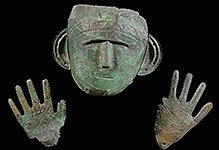
Iron Age
pre-Roman Iron Age: Hallstatt period, Latene period

#01010423
A dying Gaul at the feet of the Goddess Themis. Zeus Altar, erected 180 BCE by E...

#010301 2
Servian fortification wall near the railway station in Rome, Italy,...

#010301 3
Servian fortification wall near the railway station in Rome, Italy,...

#01030145
The bishop's church of Aguntum, once a Celto-Roman templ...

#030303 8
Dancer.Detail of a black earthenware vessel with stamp decoration fr...

#030303 9
Woman with lyre.Detail of a black earthenware vessel with stamp decoration fr...

#03030310
Geometric design and stamp ornament.Detail of a black earthenware vessel from...

#03030314
Pottery cinerary urn shaped like a hut, early Italian Iron Age, Villanova, 900-8...

#03030369
Weaving combs made of bone. Finds from the early phase of the Iron Age, corresp...

#03050663
Lady of Elche. Painted limestone bust; from L'Alcúdia, Spain; 4th century BCE....

#03050664
Bronze dagger and scabbard with figures of animals. Celtic; 6th century BCE.

#03050665
Bronze fibula in shape of a human figure. Celtic; from Hradek near Manetin, Boh...